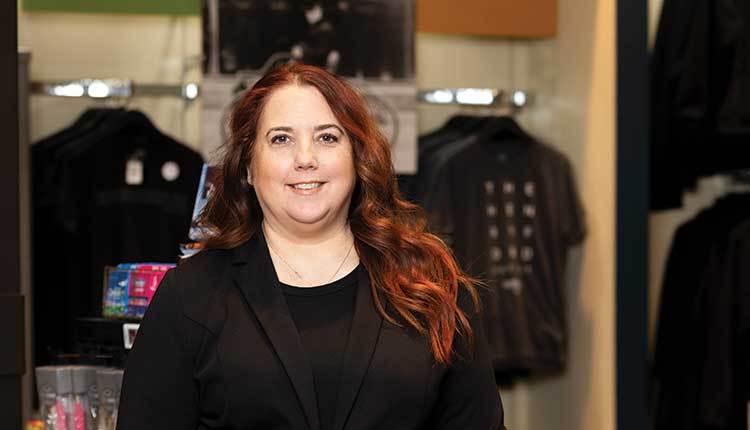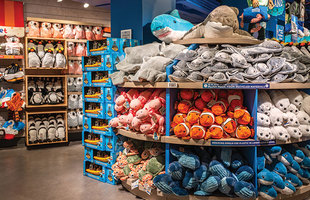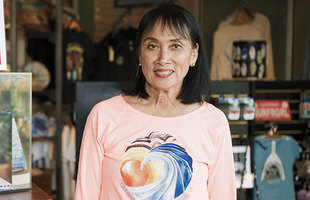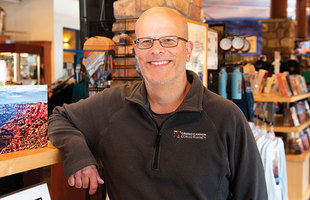People know Henry Ford for his automobiles and innovative assembly line technique he popularized in the early 20th century. Naturally, when people first hear about The Henry Ford Museum and Greenfield Village in Dearborn, Michigan, they think “cars” and “factories.” Although the museum and village certainly present exhibits and attractions related to Ford’s innovations, visitors are often surprised to find out that the destination offers much more than just “cars.”
“A lot of people have the misconception that it’s just cars here. But it’s really the museum of American innovation,” describes Erica Sims, who oversees retail for The Henry Ford.
It’s retail operations also cover the gamut of offering products that honor invention, innovation and craftsmanship as well as tried and true souvenirs and gifts with destination and location name drops.
Throughout his lifetime, Ford loved collecting antiques from American history — items from people he looked up to, objects from ordinary people and some examples of industrial progress.
According to The Henry Ford, the automotive mogul moved his collection of antiques into an abandoned tractor assembly building in Dearborn in the early 1920s. And from that collection, The Henry Ford Museum was born.
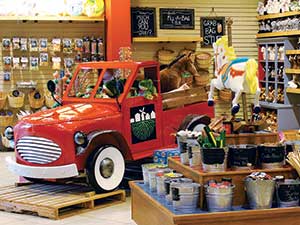
The Greenfield Village Shop, top left, focuses on home-living items, while offerings at The Henry Ford Museum Shop, bottom left, reflect the exhibits.
Photos: The Henry Ford
But Ford wanted the destination in Dearborn to be more than just a museum housing antiques — he wanted the museum to tell stories of technological progress while also offering an outdoor village to showcase how these antiques were practically used. So, in the late 1920s, Ford created Greenfield Village to help visitors experience American innovation.
“Henry Ford developed the site of Greenfield Village and the Henry Ford Museum as a way of sort of preserving components of American history as well as providing a teaching opportunity,” explains Josh Wojick, senior manager of retail sales and craft production at The Henry Ford.
Today, The Henry Ford offers four attractions at the 250-acre campus, including the museum, the village, a Ford Rouge Factory Tour and a Giant Screen Experience. The spacious campus features five retail shops: The Henry Ford Museum Shop, Genius At Play, The Greenfield Village Shop, Liberty Craftworks and Ford Rouge Factory Tour Store.
As retail general manager employed by Event Network, Sims oversees retail for The Henry Ford, and has her office there. Wojick and his team have been collaborating with the San Diego-based retail partner for more than 15 years to manage the five stores at The Henry Ford.
Sims, who grew up in Michigan, says she has countless memories of visiting The Henry Ford throughout her childhood.
“If you are from this area, when you’re in elementary school, one of your field trips is coming to The Henry Ford,” she says.
When a friend told Sims about a job opening in retail at the museum, she hopped on the opportunity. “I have memories of coming here, and I want to make sure that the guests today are having the same experience that I had,” Sims shares.
Telling stories
The retail team at The Henry Ford aims to offer a unique experience for guests visiting each of its five stores on the campus.
Sims notes that she likes to set up a variety of “stories” for guests at each store — themed, attention-grabbing displays that make it easy for people to find what they’re looking for to remember their trip.
For instance, she set up a Detroit-themed merchandise table right at the front of the Henry Ford Museum Store.
“As soon as you walk in the store, everything Detroit related is on a table — hats, shot glasses, drinking glasses, sweatshirts, T-shirts,” she says. “We want to make sure we make that experience the best for the guest by having everything in one spot. We don’t want them to have to go all over the store to get something that’s Michigan or Detroit related.”
The main museum store also offers products related to popular museum exhibits, such as presidential limousines. Sims says, “That is one of the top exhibits we get asked about, so we have replicas of those, postcards of those.”
The museum also offers its Genius At Play store by its Mathematica exhibit. Added in 2015, the store focuses on science-based toys.
While the Greenfield Village Store offers some Michigan name-dropped merchandise like the main museum store, Sims says that store focuses on offering home-living items related to attractions around the village.
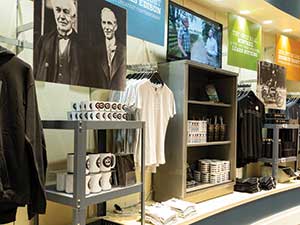
Visitors to The Henry Ford can pay tribute to the pioneer of the automotive industry with a wide selection of keepsakes.
Photos: Kristina Sikora
Greenfield Village also features the Liberty Craftworks store, which sells handmade crafts. Artists work in glassblowing, pottery, weaving and printmaking studios on the campus to showcase those skills to guests as well as to sell their work in the Liberty Craftworks store.
“We make about 10,000 pieces a year for each of those studios,” he says. “We have full-time and part-time artists working together in the shop. They put on quite a bit of a production, so it’s really a unique spot. You’re demonstrating to the public, but you’re also a production studio.”
And naturally, the Ford Rouge Factory offers a gift shop for guests who toured the plant, carrying all things Ford related. Sims says that shop offers wholesale products prominently featuring the Ford Motor Co. logo.
While merchandise sold at each of The Henry Ford’s five stores might overlap, Sims tries to limit it.
“Every single store, you want the guest to come in and have a different experience,” she says. “You don’t want them to go from the museum store to the village store and see the same product. That’s the hardest part of this whole equation, making sure every store feels special.”
Popular picks
Different souvenirs sell well at each of the stores on the campus. For the main museum store, hand towels are a hit, particularly among tourists arriving via one of the area’s Great Lakes cruises.
“During May until the last week of September, we have two to three ships per week come in, and those guests love hand towels,” says Sims.
The ones that say “Detroit,” “Michigan” or “The Henry Ford,” are top sellers. Guests also like that they fit in a suitcase. “We can sell 50 a day. It’s crazy,” adds Sims.
Ford Rouge Factory Tour guests, on the other hand, appreciate anything branded toward the F-150: F-150 hats, F-150 T-shirts or small die-cast F-150 trucks. Kids checking out Genius at Play enjoy pullback toy trucks and quirky pencil sharpeners.
But the most popular product across The Henry Ford campus is Liberty Craftworks’ Candy Cane Collection. Every year for the past two decades, Henry Ford’s glassblowers make a new line of bulbs, bowls and ornaments for its Candy Cane Collection. The collection includes 7,000 ornaments for $30 each, 250 bowls for $155 each and 40 limited edition bulbs for $155 each.
The design, pattern and color pallet changes annually and there’s a collector base that buys them every year.
“I think there’s a level of artistry that people enjoy about them,” says Wojick. “And at the end of the year when that design is done, we’re no longer making it again. There’s a level of exclusivity to the pattern and the design.”
Focus on innovation
This year, Sims says her team is working to revitalize the Greenfield Village shop to give it what she calls a “modern farmhouse” look. She says the updates should help the shop to appeal to a wider customer base.
Sims adds that Henry Ford plans to update some fixtures and paint in its Henry Ford Museum shop as well this year.
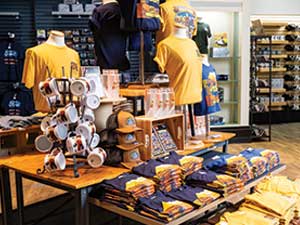
The Henry Ford Museum Shop features Detroit and Michigan related hats, mugs, glasses and apparel.
“We want to make everything more modern, especially because this is all about innovation here at the museum — we want to be more innovative,” she says
Wojick says Henry Ford has always been proactive about refreshing and modernizing all of its stores over the years to remain inspired by its collections and tied to its programming and branding.
“When we purchase something, there has to be a connection,” she explains. “Even though a product sold really well at another museum or attraction doesn’t mean we will take it on here. There has to be a tie in. We have to be really intentional.”
Part of how the retail team does that is making sure merchandise at each store connects to experiences in a particular section of The Henry Ford, be it the museum, the village or the factory. Wojick says customers appreciate when a store connects to an experience at an attraction.
“When people come to the museum, they’re coming to the museum to have an experience. The retail expressions and offerings are really driving to be connected to that experience,” says Wojick. “When you can have that ‘wow’ moment or that ‘aha’ moment within the museum and then have that reflected within the experience in the stores, I think that’s really where we’ve been successful.”
